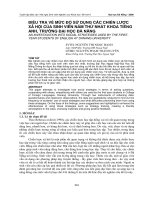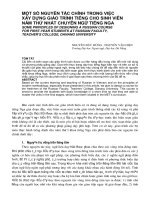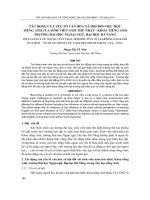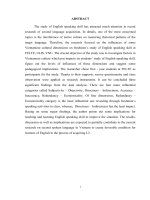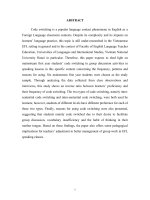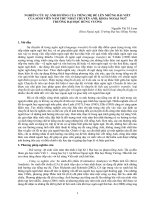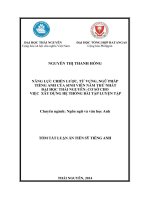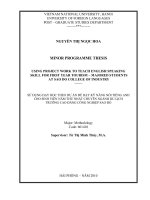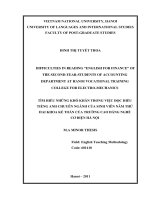Hiệu quả của việc sử dụng viết tiếng Anh sáng tạo để tạo không khí học tập đầu buổi học cho môn thực hành tổng hợp của sinh viên năm thứ nhất chuyên ngành tiếng
Bạn đang xem bản rút gọn của tài liệu. Xem và tải ngay bản đầy đủ của tài liệu tại đây (1.51 MB, 55 trang )
VIETNAM NATIONAL UNIVERSITY, HANOI
UNIVERSITY OF LANGUAGES & INTERNATIONAL STUDIES
FACULTY OF POST – GRADUATE STUDIES
*****************
PHM TH THU TRANG
THE EFFECTIVENESS OF USING CREATIVE WRITING IN
WARM-UP ACTIVITIES TO MOTIVATE FIRST-YEAR
ENGLISH MAJOR STUDENTS AT NATIONAL ECONOMICS
UNIVERSITY IN INTEGRATED SKILLS LESSONS
MA MINOR THESIS
English Methodology
601410
Hanoi - 2010
VIETNAM NATIONAL UNIVERSITY, HANOI
UNIVERSITY OF LANGUAGES & INTERNATIONAL STUDIES
FACULTY OF POST – GRADUATE STUDIES
*****************
PHM TH THU TRANG
THE EFFECTIVENESS OF USING CREATIVE WRITING IN
WARM-UP ACTIVITIES TO MOTIVATE FIRST-YEAR
ENGLISH MAJOR STUDENTS AT NATIONAL ECONOMICS
UNIVERSITY IN INTEGRATED SKILLS LESSONS
(Hiệu quả của việc sử dụng viết tiếng Anh sáng tạo để tạo không khí học tập đầu
buổi học cho môn thực hành tổng hợp của sinh viên năm thứ nhất chuyên ngành
tiếng Anh thương mại - Đại học Kinh tế Quốc dân)
MA MINOR THESIS
Field: English Methodology
Code: 60.14.10
Supervisor: Phan Thị Vân Quyên , MA
Hanoi - 2010
iv
TABLE OF CONTENTS
DECLARATION i
ACKNOWLEDGEMENTS ii
ABSTRACT iii
TABLE OF CONTENTS iv
LIST OF TABLES vii
LIST OF FIGURES viii
ABBREVIATIONS ix
Chapter 1: INTRODUCTION 1
1.1. Rationale 1
1.2. Aims of the study 3
1.3. Research questions 4
1.4. Methods of the study 4
1.5. Scope of the study 4
1.6. Contribution of the study 5
1.7. Design of the study 5
Chapter 2: THEORETICAL BACKGROUND 6
2.1. Warm-up activities 6
2.1.1. Definitions of warm-up activities 6
2.1.2. The importance of warm-up activities 6
2.2. Motivation 7
2.2.1. Definitions of motivation 7
2.2.2. Sources of motivation 8
2.3. Creative writing 8
2.3.1. Definitions of creative writing 8
2.3.2. Types of creative writing 9
2.3.3. Benefits of creative writing 10
2.3.3.1. For language learners 10
2.3.3.2. For language teachers 12
2.3.4. How to make creative writing work in the classroom 12
2.3.4.1. What to write in the classroom 12
v
2.3.4.2. Starting up 13
2.3.4.3. Writing 13
2.3.4.3. Presenting and feedback 13
Chapter 3: THE APPLICATION OF SOME CREATIVE WRITING ACTIVITIES
IN THE WARM-UP STAGE TO MOTIVATE FIRST-YEAR ENGLISH MAJOR
STUDENTS AT NEU IN INTEGRATED SKILLS LESSONS 14
3.1. Subjects 14
3.2. The Integrated Skills course 14
3.3. Procedures for applying creative writing activities 14
3.4. Schedule of applying creative writing activities 15
3.5. Descriptions of activities applied and students’ selected works 16
3.5.1. In another‟s shoes (Autobiography) 16
3.5.2. Love poems (Collaborative poem) 17
3.5.3. “Bosses never say …” 17
3.5.4. Truth telling cards 18
3.5.5. Pizza recipe 18
3.5.6. Messages in a bottle 19
3.5.7. Diamante poems 20
3.5.8. Mailbox 21
3.5.9. Round robin (Collaborative stories): An unforgettable weekend trip 22
Chapter 4: THE STUDY ON THE EFFECTIVENESS OF CREATIVE WRITING
ACTIVITIES IN THE WARM-UP STAGE TO MOTIVATE FIRST-YEAR
ENGLISH MAJOR STUDENTS AT NEU IN INTEGRATED SKILLS LESSONS . 23
4.1. The instruments 23
4.1.1. Questionnaire 23
4.1.2. Classroom observation 24
4.2. Procedures for the study 24
4.3. Data analysis and findings 25
4.3.1. Questionnaire 25
4.3.2. Classroom observation 35
4.4. Summary of the findings 35
Chapter 5: PEDAGOGICAL IMPLICATIONS 37
vi
5.1. Available sources of creative writing activities 37
5.2. How to make creative writing activities fit in the warm-up stage 37
Chapter 6: CONCLUSION 39
6.1. Summary of the study 39
6.2. Limitations of the study 39
6.3. Suggestions for further research 39
REFERENCES I
APPENDIX IV
vii
LIST OF TABLES
Table 1. Summary of Sample Profile in the First Semester 26
Table 2. Students‟ Assessment of Creative Writing Activities 28
Table 3. Students‟ Opinions about the Influence of Creative Writing on Their Attitude
towards Writing 30
Table 4. Students‟ Difficulties in Participating in Creative Writing Activities 32
Table 5. Students‟ Suggestions to Better Creative Writing Activities 33
viii
LIST OF FIGURES
Figure 1. Kinds of Warm-up Activities Used in Integrated Skills Lessons 26
Figure 2. Types of Warm-up Activities That Students Liked Best 27
Figure 3. Students‟ Assessment of Difficulty Level of Creative Writing Activities 29
Figure 4. Creative Writing Task Types That Students Liked Best 31
Figure 5. Students‟ Opinions on Whether Creative Writing Activities Should Be
Incorporated in the Warm-up Stage of Integrated Skills Lessons 34
ix
ABBREVIATIONS
ESL:
English as a Second Language
NEU:
National Economics University
1
Chapter 1: INTRODUCTION
1.1. Rationale
“Without change there is no innovation, creativity, or incentive for improvement. Those
who initiate change will have a better opportunity to manage the change that is
inevitable.” (Brown, 1994).
Following this philosophy, Faculty of Foreign Languages at the National Economics
University (NEU) conducted a survey on the effectiveness of all subjects in the first
semester of academic year 2009-2010 in order to make necessary improvements. The most
interesting responses emerged in the subject called Integrated Skills. Students thought that
it should have been removed from the curriculum because unlike what its name suggested,
the content was similar to a speaking course with the domination of speaking activities.
Moreover, not surprisingly, writing was the most ignored skill. It was viewed as difficult,
boring and unrewarding for students and time-consuming, monotonous for teachers, both
to prepare and assess. This fact posts the question of how to change the attitude of students
and teachers towards writing to better Integrated Skills lessons.
This imbalance derives from the great difficulties in mastering writing skills. The writing
process requires students to use many cognitive and linguistic strategies of which they
may be uncertain. Furthermore, the obsession of being blocked due to lack of ideas
gradually drives the interest in writing out of students. Without a genuine interest or
enjoyment of writing, students begin to develop a negative attitude towards writing. This
attitude restricts their ability to improve themselves as a writer and can lead to students
“shutting down” when they come to writing. In addition, the monotonous writing lessons
contribute to constructing students‟ poor motivation in writing. When writing is taught to
second language learners, as Stephen Davies (1998, pp.25-26) discusses in English
Teaching Forum, it is generally restricted to “fill-in-the-blank exercises which focus on
accuracy rather than the composing process." This type of accuracy, as Davies notes, is
certainly desirable in many instances, but an abuse of these writing tasks may make
students stifle and find reluctant to lift a pen.
2
These above facts indicate that the most common problem facing teachers of writing does
not lie so much on what to ask students to write about; the difficulty is more on how to
stimulate students to write eagerly and effectively.
Creative writing seems to present a great solution to this problem as Brophy (2003)
suggests “Creative writing courses offer a passport to fun in language classrooms”. It
puts the fun back into writing by giving students a break from formal essay writing.
Students who venture into creative writing classrooms learn that writing is a means of self-
expression and by exploring ideas and experimenting with language, their confidence to
communicate can grow. They feel happy, relaxed, and more than a little fired up. They
have a real sense of owning their work and of seeing the target language as a personal
asset. The process is both enjoyable and satisfying.
However, it is not surprising that Vietnamese teachers of English still question the
feasibility of this idea. As creative writing has no traditions in Vietnam‟s school
curriculum, this skeptical attitude comes as no surprise. In teachers‟ belief, creative
writing, while not valueless, is hardly worth the effort in English language teaching. It is
often associated with works that require artistic merits such as poetry, fiction, playwriting,
etc. Thus, even many native speakers are not capable of creative writing regardless of ESL
students who are unfamiliar with the myriads of idiomatic expressions and the
idiosyncrasies of the English language. Therefore, creative writing cannot function well in
English language teaching. In addition, even when creative writing is introduced into the
syllabus, it is difficult to decide how it should be delivered. Still, most teachers are unsure
of how they could apply this to language learning, which, especially in the early stages, can
be somewhat mechanical and precise. There is a tendency to think students can only be
creative with a language once they have full control with a wide vocabulary and a full
understanding of the mechanics of a language‟s grammar.
In fact, creative writing is worth an attempt. Firstly, in language classrooms under
teachers‟ proper management, creative writing works in the way that does not aim at
turning students into writers or poets but it ignites their creativity and motivates them to
write. Secondly, even beginner learners can be creative in the way they use language
although they only have a little to play with. Using learnt language creatively is a tool to
3
reinforce it. The creativity comes in making the most of the language that is known
(Jenkins, 2001). Thus, students should, from the outset, be allowed and encouraged to use
their language in an unrestricted way, so that it can become truly theirs. Last but not least,
creative writing offers a variety of genres to enable students to flex their creative muscles.
Therefore, it can serve students‟ different tastes and interests. It challenges students to
think, practice proper English mechanics and yet still keeps their interest. Overall, creative
writing activities help get the creative juices flowing and make the writing process more
stimulating and effective.
These issues suggest a need for more studies on creative writing in language teaching.
Among many attempts to make it part of the curriculum, efforts have focused on running a
creative writing course separately. Nonetheless, due to time constraints and the rigidly set
curriculum of Vietnamese universities, this idea seems impractical. In addition, little has
been documented concerning how to include creative writing in a course syllabus to
motivate students. These facts raise the questions on the possibility of making creative
writing fit in and work in the teaching of a given subject in the current university
curriculum.
It is obvious that creative writing is a useful refreshing approach to teaching writing.
Therefore, it can be incorporated in the warm-up stage of Integrated Skills lessons at NEU
to change students‟ attitude towards writing skills by offering them positive and creative
experiences with writing. Inspired by the thought that every positive idea has within its
potential for success if it is managed properly and after doing a lot of literature review, the
researcher tries her hand at this and the course has earned a significant success.
1.2. Aims of the study
The study aims at
Igniting students‟ creativity in learning writing.
Introducing a new way to refresh Integrated Skills course to teachers.
Assessing the effectiveness of creative writing activities in the warm-up stage of
Integrated Skills lessons to increase students‟ motivation.
4
Investigating the influence of creative writing activities on students‟ attitude
towards writing.
Identifying the creative writing task types that work best as warm-up activities of
Integrated Skills lessons.
Offering some solutions to improve the teaching and learning of creative writing.
1.3. Research questions
The research questions are addressed as follows:
1. How effective is creative writing in
warming up first-year English major students at NEU in Integrated Skills
lessons?
changing their attitude towards writing?
2. What creative writing task types work best as warm-up activities of Integrated
Skills Lessons?
3. What should be done to better the teaching and learning of creative writing?
1.4. Methods of the study
This research is a case study on a fresh approach to introducing creative writing into
Integrated Skills lessons. A combination of quantitative and qualitative instruments is
employed for data gathering purposes. They consist of a questionnaire for students and
classroom observation. The analysis will be done both quantitatively and qualitatively.
1.5. Scope of the study
The study was carried out on only the first-year English major students at NEU. It focuses
on piloting different creative writing activities to find out whether they work in the warm-
up stage to motivate students. Due to time constraints and the scope of a minor thesis, just
nine activities are incorporated in the course.
5
1.6. Contribution of the study
The study highlights the feasibility of integrating creative writing into the warm-up stage
of the subject namely Integrated Skills to make the lessons more fun and stimulating. Thus,
it helps raise teachers‟ awareness of a new approach to improving language teaching. More
significantly, it offers the pedagogical implications for further applications of creative
writing in the classroom.
1.7. Design of the study
The thesis is composed of six chapters.
Chapter 1 presents an overview of the study with the rationale for conducting the research,
the aims and the research questions. It also states the research methods, narrows the scope,
stresses the contribution and outlines the content of the study.
Chapter 2 provides a theoretical framework for the study, including literature review of
warm-up activities, motivation and creative writing.
Chapter 3 reveals the whole picture of the subjects in the study, the Integrated Skills
course, the procedures based on which the study is carried out, the schedule of the
teaching, and more importantly the descriptions of the activities applied with students‟
selected works respectively.
Chapter 4 reports the methodology used in the research including instruments and the
procedures for data collection and analysis. The major findings are also discussed.
Chapter 5 offers useful pedagogical implications for future creative writing courses.
Chapter 6 summarizes the study, points out the limitations and provides some suggestions
for further studies.
6
Chapter 2: THEORETICAL BACKGROUND
2.1. Warm-up activities
2.1.1. Definitions of warm-up activities
According to Catherine Blundell (2002), “Warm-up activities are any types of activities
which students engage in as preparation for a lesson.” The activities proposed may vary
greatly in their length and in the amount of student input needed to complete them. They
could require a low-level of student interaction (e.g. showing a photograph or picture to aid
understanding of the context), or they could involve using other skills and require more
student input (e.g. asking students to complete a class survey about a relevant topic). The
type of a warm-up activity proposed will depend largely on the type of tasks to follow and
the types of learners who are doing the task.
2.1.2. The importance of warm-up activities
Warm ups often receive less attention than they deserve. Teachers spend a lot of time
preparing explanations and worksheets to introduce and practice the target language. They
then enter the classroom unprepared for the first five or ten minutes. "Let's do something
fun" usually constitutes all the planning that goes into this stage of the lesson. But a well-
planned, effective warm up offers more towards the lesson than just a bit of fun. In fact,
these activities are very important for the following reasons:
“The warm up sets the tone for the lessons.” (Cotter, 2005). An activity that students find
too difficult, or even confusing, results in a class of disinterested zombies. This then
translates into a quiet class session in which teachers have to prod and push students to
volunteer examples or simple answers. A fun warm up, on the other hand, raises energy
levels and creates a positive atmosphere for students to practice and experiment with the
language.
As Penny Ur & Andrew Wright (1992) cited, the warm up gets students into "English
mode." If English is taught as a second language, the lesson may represent the only chance
for students to use the language. They might not have spoken English since the last
session, which can be two days, one week, or one month ago.
7
According to Peter Watcyn-Jones (1995), warm ups provide a transition into the topic or
target language of the lesson. An activity at the start of the lesson activates pre-existing
knowledge on a subject, and may even get students to use some of the ideas, vocabulary, or
even grammar important to the lesson.
Warm ups allow the teacher important opportunities to assess character and ability. (Cotter,
2005). After all, some students work well together, and others do not. Some students have
good days, and others bad. During the initial activity, the teacher can determine who will
form the best groups for subsequent activities.
2.2. Motivation
2.2.1. Definitions of motivation
The word “motivation” appears to be simple and easy, but it is so difficult to define. It
seems to have been impossible for theorists to reach a consensous on a single definition.
Martin Convington (1981, p.1) states that “Motivation, like the concept of gravity, is easier
to describe – in terms of its outward, observable effects – than it is to define.” Thus, a few
definitions were found during the research process. According to Keller (1983), motivation
is the degree of the choices people make and the degree of effort they will exert.
Motivation is also defined as the impetus to create and sustain intentions and goal seeking
acts (Ames, C. & Ames, O., 1989). A close examination of these definitions shows that
motivation is defined in different ways by different researchers, but they tend to agree that
motivation is responsible for determining human behavior by energizing it and giving it
direction.
Motivation is one of the most important factors in language learning. To motivate means to
provide the primary impetus to initiate foreign language learning and later the driving force to
sustain the long and often tedious learning process. Zoltán Dǒrnyei (1998, p.117) cited that
“Without sufficient motivation, even individuals with the most remarkable abilities cannot
accomplish long-term goals, and neither are appropriate curricula and good teaching enough
to ensure students’ achievement. On the other hand, high motivation can make up for
considerable deficiencies both in one’s language aptitude and learning conditions.”
8
2.2.2. Sources of motivation
One of the most general and well-known distinctions in motivation theories is that of
intrinsic versus extrinsic motivation.
Intrinsic motivation is defined as “motivation to engage in an activity because that activity
is enjoyable and satisfying to do” (Deci and Ryan, 1985, p. 39). It deals with behavior
performed for its own sake, in order to experience pleasure and satisfaction such as the joy
of doing a particular activity or satisfying one‟s curiosity.
Extrinsic motivation refers to “actions carried out to achieve some instrumental end such
as earning a reward or avoiding a punishment” (Zoltán Dǒrnyei, 1998, p. 39). Several
studies have confirmed that students will lose their natural intrinsic interest in an activity if
they have to do it to meet some extrinsic requirements. However, research has shown that
under certain circumstances - if they are sufficiently self-determined and internalized -
extrinsic rewards can be combined with or can even lead to intrinsic motivation (Zoltán
Dǒrnyei, 1998, p. 121).
In foreign language learning, students need an experience in the classroom which will
promote favorable attitudes towards learning. “It is this favorable attitude, combined with
diligent effort that composes true motivation” (Megan Downs, 2001, p. 30).
2.3. Creative writing
2.3.1. Definitions of creative writing
Creative writing is a very broad term. As essentially all types of writing are creative, it is
hard to define it.
The biggest efforts have been made on distinguishing creative writing from other writing
genders. As Brophy (2003) cited in Explorations in Creative Writing, “Creative writing is
different from everyday-ordinary-commonplace writing.” It is considered to be any
writing, fiction, poetry, or non-fiction, that goes outside the bounds of normal professional,
journalistic, academic, and technical forms of literature. Sharing the same view, Hadfields
9
(1990) points out, “Creative writing is in contrast to analytic or pragmatic forms of
writing.” It is guided more by the writer's need to express feelings and ideas than by
restrictive demands of factual and logical progression of expository writing. Creative
writing is an “art piece” of mind in which meanings burst out of the words, and the
meanings come as much from the heart as from the mind.
To give an insight into the nature of creative writing, Rozakis (1997, p. 6) writes “Creative
writing is a kind of writing that uses language in imaginative and bold ways”. It is a form
of artistic expressions which draw on the imagination to convey meaning through the use
of imagery, narrative, and drama. In other words, creative writing is an expression of
passion in one‟s heart. Its purpose is not to inform, but to reveal the writer‟s feelings.
2.3.2. Types of creative writing
According to Rozakis (1997, pp. 7-8), there are ten common types of creative writing.
a. Article: An article is a short work of nonfiction. You can find articles in magazines,
newspapers, and books.
b. Autobiography: An autobiography is a person‟s story of his or her own life. An
autobiography is nonfiction and describes key events from the person‟s life.
c. Biography: A biography is a true story about a person‟s life written by another person.
Biographies are often written about well-known people or important people.
d. Drama: Drama is a piece of literature written to be performed in front of an audience.
The actors tell the story through their actions. Drama can be read as well as acted.
e. Essays: An essay is a brief writing on a particular subject or idea.
f. Fantasy: Fantasy is a kind of writing that describes events that could not take place in
real life. Fantasy contains unrealistic characters, setting, and events. Science fiction is
fantasy writing that tells about make-believe events that include science or technology.
Often, science fiction is set in the future, on distant planets, or among alien races.
g. Novels: A novel is a long work of fiction. The elements of a novel-plot, characterization,
setting, and theme-are developed in detail. Novels usually have one main plot and several
less important subplots.
h. Poetry: Poetry is a type of writing in which words are selected for their beauty, sound,
and power to express feelings. Traditionally, poems had a specific rhythm and rhyme, but
10
such modern poetry as free verse does not have a regular beat, rhyme, or line length. Most
poems are written in lines, which are arranged together in groups called stanzas.
i. Short stories: A short story is narrative prose fiction shorter than a novel that focuses on
a single character and a single event. Most short stories can be read in one sitting and
convey a single overall impression.
j. Song lyrics: Songs are poems set to music. All songs have a strong beat, created largely
through the 3R‟s: rhythm, rhyme, and repetition.
2.3.3. Benefits of creative writing
2.3.3.1. For language learners
a. “Creative writing makes learning motivating and fun” (Viete, 2006). One of the chief
distinguishing characteristics of creative writing texts is a playful engagement with
language, stretching and testing its rules to the limit in a guilt-free atmosphere, where risk
is encouraged. Such writing combines cognitive with affective modes of thinking. Thanks
to this feature, creative writing enables students to perform better in writing.
b. According to Jeff Fearnside (2003), “Creative writing provides a chance to do
something perceived as “fun” while still requiring a lot of work from students.” The
playful element in creative writing should never be confused with a lax and unregulated
use of language. On the contrary, creative writing requires a willing submission on the part
of the writer to the „rules‟ of the sub-genre being undertaken. Interestingly enough, the
very constraints which the rules impose seem to foster rather than restrict the creativity of
the writer. This apparent paradox is explained partly by the deeper processing of thought
and language which the rules require.
c. Creative writing invites more feedback about language use. Viete (2006) explains when
students write creatively, they need to share it, not just to get a response, but to get a
response that focuses on the way they put the words together.
d. Powell (1973) stated that creative writing gives students a sense of ownership of the
language. Because people often associate creative writing with “good” writers and “good”
11
writers with the mythical “native-speaker” concept, they often believe that they will never
fully belong in the language. Writing creatively can help them believe in themselves as
owners of the language, because they get feedback about their “good” writing. Even
beginners can achieve this.
e. “Critical thinking is built into creative writing.” Jeff Fearnside (2003). Creative writing
forces students to think in ways they are not accustomed to thinking. There are no ready-
made answers. Students must ponder the problem and search not only their mental
warehouses of facts but also their imaginations to put words to paper.
f. The dramatic increase in self-confidence and self-esteem which creative writing tends to
develop among learners leads to a corresponding increase in motivation. Dornyei (2001)
among others has pointed to evidence which suggests that the key conditions for promoting
motivation are:
Creating a pleasant and supportive atmosphere.
Promoting the development of group cohesiveness.
Increasing the students‟ expectation of success in particular tasks and in learning in
general.
Making learning more stimulating and enjoyable by breaking the monotony of
classroom events.
Making learning stimulating and enjoyable by increasing the attractiveness of tasks.
Making learning stimulating and enjoyable for learners by enlisting them as active
task participants.
Presenting and administer tasks in a motivating way.
Providing students with regular experiences of success.
Building your learners‟ confidence by providing regular encouragement.
Increasing students‟ motivation by promoting cooperation among them.
Increasing students‟ motivation by actively promoting their autonomy.
Increasing learners' satisfaction.
Offering rewards in a motivational manner.
12
2.3.3.2. For language teachers
There are significant benefits to teachers if they participate in creative writing.
Creative writing is a way of recharging their batteries, giving their imagination free rein
and discovering abilities they do not know they have and would like to continue to explore.
Obviously, they feel good about themselves. The reason is a teacher who has experienced
success in an unexpected field or has found a possibility to exercise her/his mental faculties
enjoyably will find renewed vigor.
In addition, creative writing provides a very welcome and at times much needed
counterbalance to teaching, which is often ruled by curricula and constraints on language
use based on the syllabi and what the institution requires for students (academic writing).
Last but not least, it helps keep teachers‟ English fresh and vibrant because for much of the
professional lives, teachers are in thrall to the controlled language of English textbook and
the repeated low level error-laden English of their students.
2.3.4. How to make creative writing work in the classroom
2.3.4.1. What to write in the classroom
In an article on />creative-writing-language-practice, Franz Andres Morrissey writes there are no limits
in creative writing as far as genre is concerned. Students can try short stories, dialogues in
short dramatic scenes and poems. The main constraint is time and space. Most texts will
have to be relatively short. For this reason it may be useful to focus on poetry as perhaps
the most condensed of all the possible genres. It also has the double advantage that the
brevity of poems allows students to write a first draft (or much of it) in class and to present
a text in class with discussion. The problem with poetry is that many teachers are uneasy
about it because they see it as the most sublime form of writing. For students this is much
less of a problem and their writing of poems can become rather impressive once they
realize that formal constraints, especially rhyme, are not indispensable for a good poem.
13
2.3.4.2. Starting up
Less confident students may feel under pressure to turn in a masterpiece, which may block
them in their writing. To prevent this it pays to do the first acts, either orally and/or in
groups. Students can first explore an idea together, possibly without committing
themselves on paper. If we want to explore a whole range of activities connected to a given
field in class, for example, in characterization, it pays to produce the topic with a playful
opening activity, ideally connected to the sort of language games students may play in their
own language or in class, and to make use of the fact that most people find talking easier
that writing. This opens ways into the field that are easy and non-threatening.
2.3.4.3. Writing
Much of this can happen outside the classroom with the exception of activities that
require interaction. For example, if two students write alternative lines of a poem in a
“ping pong” writing activity (both students write, say, a line of a poem, then exchange their
sheets and write the next line of the poem, reacting to what the partner put there, then swap
back, add another line to the one the partner wrote and continue until the text is finished).
Students should also be encouraged to rewrite the first drafts (which help to improve the
language and the choice of vocabulary), Morrissey adds.
2.3.4.4. Presenting and feedback
A very important part of the creative writing process generally is presentation of
texts or feedback to be incorporated in re-writes. For language training, this opens up a
range of possibility, from suggestions for improvements of the text to group discussions.
14
Chapter 3: THE APPLICATION OF SOME CREATIVE WRITING ACTIVITIES
IN THE WARM-UP STAGE TO MOTIVATE FIRST-YEAR ENGLISH MAJOR
STUDENTS AT NEU IN INTEGRATED SKILLS LESSONS
3.1. Subjects
The participants were 60 first-year students from Department of Business English - Faculty
of Foreign Languages. They came from classes A1, A2, and A3 with 20 students per class.
At high school, the traditional teaching method in English developed a passive learning
style among them. However, the first semester at NEU provided them with a lot of exciting
English lessons. They were now eager to learn and became more active in the lessons.
Furthermore, majoring in English, they longed for not only mastering English but also
discovering the beauty of English language.
3.2. The Integrated Skills course
The course was a 15-week course offered to first-year students of Department of Business
English in the second semester. There were two periods of a 90-minute Integrated Skills
lesson a week. In this course speaking, listening, reading and writing were taught in
integration. The course book was compiled by the teachers from different sources. Students
had received the syllabus one week before the course started. All lessons were generally
organized around a communicative task-cycle.
Notably, in the first semester, the survey conducted by Faculty of Foreign Languages
showed that students were not satisfied with the quality of Integrated Skills lessons.
Speaking activities dominated the class and writing skills were frequently ignored.
Students had no motivation in writing and teachers got stuck. To solve this problem,
creative writing was introduced into the warm-up stage of Integrated Skills lessons with
the hope of freshening the course.
3.3. Procedures for applying creative writing activities
At the very beginning of the study, permission was gained from the Head of Department of
Business English who showed a willingness to collaborate in the study. The course
syllabus was examined to select the creative writing activities that would fit in the lesson
contents. A detailed schedule was set and followed strictly.
15
In the course, students worked individually or cooperated with others depending on the
type of activity itself. Nevertheless, most creative writing activities took pair or group
formats both to save time and to maximize students‟ working time. The class was divided
into groups of four or five. Clear, detailed instructions were supplied and the time limit
was set for each task. During the writing process which took from seven to ten minutes, the
teacher moved around the class and offered help if necessary. Each group then presented
their writing pieces orally. The peer‟s and teacher‟s comments were provided right after
each presentation. It should be noted that due to the small class size (20 learners per class),
creative writing activities functioned well in fifteen minutes intended for the warm-up
stage because there were just four or five short presentations. Next, the teacher collected all
students‟ works and gave more comments at home. In the following lesson, these pieces
would be stuck up on the notice board in the classroom to invite more feedback from
students.
3.4. Schedule of applying creative writing activities
Week
Date
Units
Creative Writing
Activities as Warm-ups
1
8
th
March 2010
Who‟s Who?
In another‟s shoes
(Autobiography)
3
25
th
March 2010
I Will Always Love
You
Love poems
(Collaborative poem)
4
29
th
March 2010
Company Culture
“Bosses never say …”
6
12
th
April 2010
Best friends
Truth telling cards
7
19
th
April 2010
The Mother of
Invention
Pizza recipe
9
3
rd
May 2010
I Was Only
Dreaming
Messages in the bottle
10
24
th
May 2010
A Moment in Time
Diamante poems
13
14
th
June 2010
I Used to Be a
Rebel
Mailbox
14
21
st
June 2010
What a Week!
Round robin
(Collaborative stories): An
unforgettable weekend
trip
16
3.5. Descriptions of activities applied and students’ selected works
3.5.1. In another’s shoes (Autobiography)
Activity descriptions: Teachers hang ten pictures of people cut from newspapers on the
board. Students work in groups of four to choose a picture, imagine and write a life story
of the person in the picture for ten minutes. They must use the pronoun “I” in their story.
Then the group‟s representatives will read their story out loud. Others will guess who is
who.
Students’ works:
I live in a small village. My life is hard and full of physical
labor. I hardly have any spare time and I work almost seven
days a week. I have a lot of experience in handling a farm.
Farming is a good career and it requires hard work. You will
find that what you put into it, you will get it back. Therefore, it
is worth the effort. Another thing is that I am my own boss. I go when I like and I come when I
please.
(By Thai Bao Son – Tran Thu Trang – Phi Van Long – Nguyen Ngoc Trinh)
My life has changed radically after only one night, like a dream. I still
remember the feeling I got when I was on stage and won The 2007 Miss
World title. Since then, I took more responsibility with society and did a
lot of charity work in different countries and regions. I had chance to
travel to more than twenty countries so as to do voluntary work and
carried out many tasks which each Miss World should get involved. I hope
that people will not only know me as the tallest Chinese beauty queen but also the most warm-
hearted Miss World.
(By Nguyen Nhat Minh – Vu Nhat Ha – Phan Thanh Dung – Thai Yen Ni)
17
3.5.2. Love poems (Collaborative poem)
Activity descriptions: Students work in groups of four and take turns to write one line of
the love poem in the format given below in ten minutes.
WORD A (love theme)
2 adjectives (describing word A)
3 gerunds (describing word A)
1 short, complete sentence (about word A)
3 gerunds (describing word A)
2 adjectives (describing word A)
WORD B (love theme)
Students’ works:
Love
Sweet Bitter
Smiling Missing Kissing
Love is a heaven, a hell or both.
Confusing Sharing Waiting
Unforgettable Blue
Memory
(By Le Thuy Chi – Ly Hai Linh –
Nguyen Tuan Nam – Le Ngoc Ha)
Love
Sweet Romantic
Flirting Dating Kissing
Love is selfish, blind and greedy.
Exhausting Arguing Breaking-up
Hopeless Hopeful
Marriage
(By Pham Van Bau – Mai Hoai –
Le Thu Hang – Le Giang)
3.5.3. “Bosses never say …”
Activity descriptions: The class is divided into groups of five to write down in a piece of
paper what they think that the bosses never say to their employees. After ten minutes, they
will read out loud their sentences to the whole class.
Students’ works:
Bosses never say …
… “Salaries will be raised every month.”
